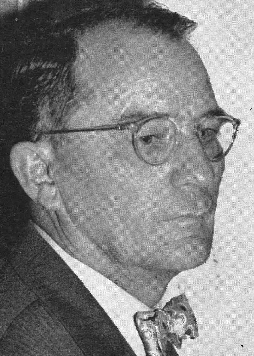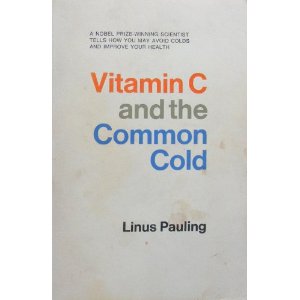
Linus Carl Pauling was an American chemist, biochemist, chemical engineer, peace activist, author, and educator. He published more than 1,200 papers and books, of which about 850 dealt with scientific topics. New Scientist called him one of the 20 greatest scientists of all time, and as of 2000, he was rated the 16th most important scientist in history. For his scientific work, Pauling was awarded the Nobel Prize in Chemistry in 1954. For his peace activism, he was awarded the Nobel Peace Prize in 1962. He is one of five people to have won more than one Nobel Prize. Of these, he is the only person to have been awarded two unshared Nobel Prizes, and one of two people to be awarded Nobel Prizes in different fields, the other being Marie Curie.

Glutamine is an α-amino acid that is used in the biosynthesis of proteins. Its side chain is similar to that of glutamic acid, except the carboxylic acid group is replaced by an amide. It is classified as a charge-neutral, polar amino acid. It is non-essential and conditionally essential in humans, meaning the body can usually synthesize sufficient amounts of it, but in some instances of stress, the body's demand for glutamine increases, and glutamine must be obtained from the diet. It is encoded by the codons CAA and CAG.
Nosology is the branch of medical science that deals with the classification of diseases. Fully classifying a medical condition requires knowing its cause, the effects it has on the body, the symptoms that are produced, and other factors. For example, influenza is classified as an infectious disease because it is caused by a virus, and it is classified as a respiratory infection because the virus infects and damages certain tissues in the respiratory tract. The more that is known about the disease, the more ways the disease can be classified nosologically.

Anemia or anaemia is a blood disorder in which the blood has a reduced ability to carry oxygen due to a lower than normal number of red blood cells, a reduction in the amount of hemoglobin or hemoglobin abnormalities. The name is derived from Ancient Greek: ἀναιμία anaimia, meaning 'lack of blood', from ἀν- an-, 'not' and αἷμα haima, 'blood'. When anemia comes on slowly, the symptoms are often vague, such as tiredness, weakness, shortness of breath, headaches, and a reduced ability to exercise. When anemia is acute, symptoms may include confusion, feeling like one is going to pass out, loss of consciousness, and increased thirst. Anemia must be significant before a person becomes noticeably pale. Symptoms of anemia depend on how quickly hemoglobin decreases. Additional symptoms may occur depending on the underlying cause. Preoperative anemia can increase the risk of needing a blood transfusion following surgery. Anemia can be temporary or long term and can range from mild to severe.
Orthomolecular medicine is a form of alternative medicine that aims to maintain human health through nutritional supplementation. The concept builds on the idea of an optimal nutritional environment in the body and suggests that diseases reflect deficiencies in this environment. Treatment for disease, according to this view, involves attempts to correct "imbalances or deficiencies based on individual biochemistry" by use of substances such as vitamins, minerals, amino acids, trace elements and fatty acids. The notions behind orthomolecular medicine are not supported by sound medical evidence, and the therapy is not effective for chronic disease prevention; even the validity of calling the orthomolecular approach a form of medicine has been questioned since the 1970s.
Orthomolecular psychiatry is the use of orthomolecular medicine for mental illness. The approach uses unorthodox forms of individualized testing and diagnosis to attempt to establish an etiology for each patient's specific symptoms, and claims to tailor the treatment accordingly, using a combination of nutrients, dietary changes and medications that are claimed to enhance quality of life and functionality as well as to reduce or eliminate symptoms and the use of xenobiotic drugs. Scientific studies have shown mixed results; although there are some promising results from nutritional psychiatry, some forms of orthomolecular psychiatry are ineffective.

Abram Hoffer was a Canadian biochemist, physician, and psychiatrist known for his "adrenochrome hypothesis" of schizoaffective disorders. According to Hoffer, megavitamin therapy and other nutritional interventions are potentially effective treatments for cancer and schizophrenia. Hoffer was also involved in studies of LSD as an experimental therapy for alcoholism and the discovery that high-dose niacin can be used to treat high cholesterol and other dyslipidemias. Hoffer's ideas about megavitamin therapy to treat mental illness are not accepted by the medical community.

Vernon Martin Ingram, was a German–American professor of biology at the Massachusetts Institute of Technology.

Roger John Williams, was an American biochemist. He is known for is work on vitamins and human nutrition. He had leading roles in the discovery of folic acid, pantothenic acid, vitamin B6, lipoic acid, and avidin. He was elected to the National Academy of Sciences in 1946, and served as the president of the American Chemical Society in 1957. In his later career he spent time writing for a popular audience on the importance of nutrition.
Hemoglobin C is an abnormal hemoglobin in which glutamic acid residue at the 6th position of the β-globin chain is replaced with a lysine residue due to a point mutation in the HBB gene. People with one copy of the gene for hemoglobin C do not experience symptoms, but can pass the abnormal gene on to their children. Those with two copies of the gene are said to have hemoglobin C disease and can experience mild anemia. It is possible for a person to have both the gene for hemoglobin S and the gene for hemoglobin C; this state is called hemoglobin SC disease, and is generally more severe than hemoglobin C disease, but milder than sickle cell anemia.
Megavitamin therapy is the use of large doses of vitamins, often many times greater than the recommended dietary allowance (RDA) in the attempt to prevent or treat diseases. Megavitamin therapy is typically used in alternative medicine by practitioners who call their approach orthomolecular medicine. Vitamins are useful in preventing and treating illnesses specifically associated with dietary vitamin shortfalls, but the conclusions of medical research are that the broad claims of disease treatment by advocates of megavitamin therapy are unsubstantiated by the available evidence. It is generally accepted that doses of any vitamin greatly in excess of nutritional requirements will result either in toxicity or in the excess simply being metabolised; thus evidence in favour of vitamin supplementation supports only doses in the normal range. Critics have described some aspects of orthomolecular medicine as food faddism or even quackery. Research on nutrient supplementation in general suggests that some nutritional supplements might be beneficial, and that others might be harmful; several specific nutritional therapies are associated with an increased likelihood of the condition they are meant to prevent.
Carl Curt Pfeiffer was a physician and biochemist who researched schizophrenia, allergies and other diseases. He was Chair of the Pharmacology Department at Emory University and considered himself a founder of what two-time Nobel prize winner, [Pauling, PhD.], named orthomolecular psychiatry and published in the Journal Science. 1968 Apr 19;160(3825):265-71.
Seymour Jonathan Singer was an American cell biologist and professor of biology, emeritus, at the University of California, San Diego.
William Bosworth Castle was an American physician and physiologist who transformed hematology from a "descriptive art to a dynamic interdisciplinary science."
Richard D. Cummings is an American biochemist who is the S. Daniel Abraham Professor of Surgery at Beth Israel Deaconess Medical Center and Harvard Medical School in Boston, Massachusetts. He also the chief of the division of surgical sciences within the department of surgery. He is the director of the Harvard Medical School Center for Glycoscience, director of the National Center for Functional Glycomics, and also founder of the Glycomics Core at BIDMC. As of 2018 Cummings is also the scientific director of the Feihi Nutrition Laboratory at BIDMC. Before moving to BIDMC/HMS, Cummings was the William Patterson Timmie Professor and chair of the department of biochemistry at Emory University School of Medicine in Atlanta, Georgia from 2006 to 2015. At Emory, Cummings was a founder in 2007 of the Emory Glycomics Center.

Harvey Akio Itano was an American biochemist best known for his work on the molecular basis of sickle cell anemia and other diseases. In collaboration with Linus Pauling, Itano used electrophoresis to demonstrate the difference between normal hemoglobin and sickle cell hemoglobin; their 1949 paper "Sickle Cell Anemia, a Molecular Disease" was a landmark in both molecular medicine and protein electrophoresis, though the use of electrophoresis to separate hemoglobin variants had been pioneered by Maud Menten and collaborators some years earlier.

Vitamin C and the Common Cold is a popular book by Linus Pauling, first published in 1970, on vitamin C, its interactions with common cold and the role of vitamin C megadosage in human health. The book promoted the idea that taking large amounts of vitamin C could reduce the duration and severity of the common cold. A Nobel Prize-winning chemist and activist, Pauling promoted a view of vitamin C that is strongly at odds with most of the scientific community, which found little evidence for the alleged health benefits of greatly increased vitamin C intake. The book went through multiple editions, and a revised version that discussed the flu and other diseases, retitled Vitamin C, the Common Cold & the Flu, came out in 1976.
"Sickle Cell Anemia, a Molecular Disease" is a 1949 scientific paper by Linus Pauling, Harvey A. Itano, Seymour J. Singer and Ibert C. Wells that established sickle-cell anemia as a genetic disease in which affected individuals have a different form of the metalloprotein hemoglobin in their blood. The paper, published in the November 25, 1949 issue of Science, reports a difference in electrophoretic mobility between hemoglobin from healthy individuals and those with sickle-cell anemia, with those with sickle cell trait having a mixture of the two types. The paper suggests that the difference in electrophoretic mobility is probably due to a different number of ionizable amino acid residues in the protein portion of hemoglobin, and that this change in molecular structure is responsible for the sickling process. It also reports the genetic basis for the disease, consistent with the simultaneous genealogical study by James V. Neel: those with sickle-cell anemia are homozygous for the disease gene, while heterozygous individuals exhibit the usually asymptomatic condition of sickle cell trait.

Sickle cell disease (SCD) is a group of blood disorders typically inherited. The most common type is known as sickle cell anaemia. It results in an abnormality in the oxygen-carrying protein haemoglobin found in red blood cells. This leads to a rigid, sickle-like shape under certain circumstances. Problems in sickle cell disease typically begin around 5 to 6 months of age. A number of health problems may develop, such as attacks of pain, anemia, swelling in the hands and feet, bacterial infections, and stroke. Long-term pain may develop as people get older. The average life expectancy in the developed world is 40 to 60 years.

Hemoglobin Hopkins-2 is a mutation of the protein hemoglobin, which is responsible for the transportation of oxygen through the blood from the lungs to the musculature of the body in vertebrates. The specific mutation in Hemoglobin Hopkins-2 results in two abnormal α chains. The mutation is the result of histidine 112 being replaced with aspartic acid in the protein's polypeptide sequence. Additionally, within one of the mutated alpha chains, there are substitutes at 114 and 118, two points on the amino acid chain. This mutation can cause sickle cell anemia.









